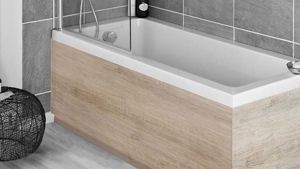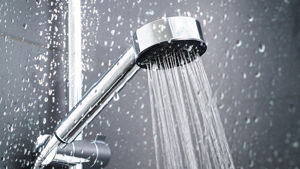Stainless steel sinks are a great addition to any kitchen but they need some TLC to keep looking their best. Watermarks and limescale are an inevitable occurrence, so knowing how to properly maintain your sink to keep it looking great for years to come is vital. These tips and tricks will help you have a clean stainless steel sink without causing any further scratches or damage.
How To Clean A Stainless Steel Sink:
You Will Need:
- Cleaning cloths/ sponges
- Vinegar
- Olive oil
- Lemon
- Baking soda
1. Rinse Out Your Sink
Before you begin cleaning it's important to rinse your entire sink with water. Using a sponge you should also remove any loose dirt or grime.
2. Apply Baking Soda
Using a spoon, take your baking soda and apply it liberally across your sink. You should aim to cover the whole sink with a thin layer including the sides of the bowl.

3. Scrub Using A Sponge
Wet your sponge and begin scrubbing the sink. The baking soda and water should create a thin paste which will coat the sink, you can add more water to achieve this paste if required.
Try and scrub in the direction of the grain of the stainless steel and pay extra attention to any areas with particularly bad dirt or limescale.
4. Apply The Lemon
Cut your lemon in half to create a handy lemon scrubber. With the baking soda still in place use the lemon to scrub across the whole of the sink. The acidity of lemon can help to fight bacteria and will also leave a pleasant lemon smell.

5.Rinse Your Sink
Using water, rinse the baking soda and lemon away from the sink. Be sure to remove all of the paste from the bowl sides and any crevices it may have got into.
6. Spray Your Sink With Vinegar
Grab a spray bottle and fill it with some white vinegar. You can then spray it liberally to cover the entire sink as you did with the baking soda. Use a clean cloth to scrub the vinegar into the sink. As with baking soda, vinegar is a great natural stain remover so pay close attention to any problem areas of your sink.
7. Dry Your Sink
Once you've finished working the vinegar into your sink, take a clean cloth and dry off the sink to remove any vinegar and water.

8. Apply Olive Oil
Although not essential, working a small amount of olive oil into your sink once it's dry can help give it a shine.
Alternative Ways To Keep Your Sink Clean
If using baking soda and vinegar hasn't given you the desired results, there's a great selection of other cleaning methods you can try.
Flour
Flour can be really useful when trying to keep your stainless steel sink looking as shiny as possible. Simply sprinkle some flour across the whole of your sink and lightly rub it in with a dry, soft cloth. Simply rinse the flour away after this and you should be left with a gorgeous shine.
Toothpaste
Regular toothpaste is mildly abrasive, which means it can help remove any minor scratches or dirt marks without damaging your sink.

Using a soft bristle toothbrush, scrub some toothpaste into any problem areas. You can use a wet cloth to clear away the toothpaste and check progress, applying more and scrubbing if necessary.
Keep It Tidy!
Regardless of how much washing up liquid is used during the daily dish wash, sinks will still inevitably collect food scraps and soap deposits which can lead to rust, and eventually water spots will appear. As a rule of thumb to stop these from occurring, you should wash the sink after around 30 uses with a non-abrasive cleaning spray and sponge. This is especially important for stainless steel sinks which are particularly vulnerable if left uncared for.
Use A Sink Protector

Certain types of sink materials and particularly stainless steel sinks can be weak against scratches from daily use. To avoid these scratches, place a protective matt in the sink to absorb the impact from utensils and dishes. A range of sink basin protectors are available depending on your style preference.








